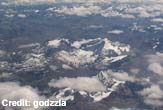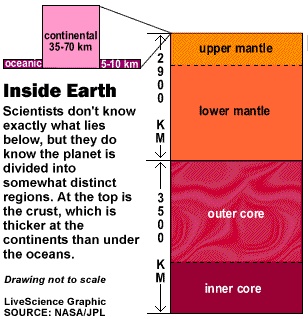Blobs Inside Earth Might Explain Rapid Mountain Building

The Andes mountains rose to their dizzying heights in as little as 7 million years, a new study concludes.
The research, reported today in the journal Science, adds to another recent study that found mountains grow much more quickly than scientists had thought.
How it's done needs to be rethought, and one idea involves a giant blob of material inside the Earth.
"These results really change the paradigm of understanding of how mountain belts grow," says Carmala Garzione at the University of Rochester. "We've always assumed that the folding and faulting in the upper crust produced high elevation mountains. Now we have data on ancient mountain elevation that shows something else is responsible for the mountains' uplift."
The challenge
As mountains rise, they are constantly weathered, making it hard for scientists to look back in the geologic record and figure out just how tall they were at any moment.
Scientists look at plant fossils in soil layers and apply knowledge of what elevations the plants would have grown at. But climates change and plants adapt, so the method is imprecise.
Get the world’s most fascinating discoveries delivered straight to your inbox.
"Estimates of the timing of mountain range formation often differ by millions of years, even for geologically young areas," write geoscientists Michael Poage and C. Page Chamberlain in a separate article in the journal analyzing the new work.
Garzione and colleagues examined sediments that had collected over time at the base of a mountain in the Andes. There she found a record of the altitude from which the sediments came, by looking at clues such as how much oxygen was in the rainwater that eroded the sediment.
The evidence suggested the Andes shot up between 10 million and 7 million years ago.
"When I first showed this data to others, they had a hard time believing that mountains could pop up so quickly," Garzione said this week.
The research was led by Prosenjit Ghosh and John M. Eiler of the California Institute of Technology.
The research team then examined the same sediment for clues about the temperatures in which it formed, another indicator of altitude. The warmer it is, for example, the more atoms are vibrating, which changes when and how their bonds break and rejoin in chemical reactions. The results pointed to the same time frame.
"With supporting data from the new paleotemperature technique, we have more confidence in the uplift history and can determine processes that caused the mountains to rise," Garzione said.
A study last June used yet a different method to determine that mountains in western Norway had been built in a surprisingly short 13 million years, rather than the 40 million that had been thought.
The blob theory
The towering South American Andes—the average height is 13,000 feet—must have risen more than half a mile every million years, according to Garzione and her colleagues.
Garzione favors a controversial theory called "deblobbing" to explain the rapid rise. It goes like this:
When two plates of Earth's crust collide, the swell of a mountain range develops. Below, in the solid portion of the upper mantle, a blob of material clings to the rising swell. The blob acts like an anchor and the mountains rise slowly. At some point, the blob disconnects and the mountains spring upward.
"Our data argue that the mantle just accumulates down there until some critical moment when it becomes unstable and drops off," Garzione said.
It might be possible to search for these blobs using seismic techniques. Perhaps one sits beneath California's Sierra Nevada range, Garzione speculates. If so, it might detach in a few million years and allow those mountains to soar.
- Mt. Everest Shorter Than Thought
- A Natural Compass: Rock Cracks Point North
- Hole Drilled to Bottom of Earth's Crust, Breakthrough to Mantle Looms
- Surprise: High Ozone Levels in Mountains of Tibet
- Image Gallery: Blue Marble Art
The crust thickness averages about 18 miles (30 kilometers) under the continents, but is only about 3 miles (5 kilometers) under the oceans. It is light and brittle and can break. In fact it's fractured into more than a dozen major plates and several minor ones. It is where most earthquakes originate.
The mantle is more flexible – it flows instead of fractures. It extends down to about 1,800 miles (2,900 kilometers) below the surface.
The core consists of a solid inner core and a fluid outer core. The fluid contains iron, which, as it moves, generates the Earth’s magnetic field. The crust and upper mantle form the lithosphere, which is broken up into several plates that float on top of the hot molten mantle below.
SOURCE: LiveScience reporting
Robert is an independent health and science journalist and writer based in Phoenix, Arizona. He is a former editor-in-chief of Live Science with over 20 years of experience as a reporter and editor. He has worked on websites such as Space.com and Tom's Guide, and is a contributor on Medium, covering how we age and how to optimize the mind and body through time. He has a journalism degree from Humboldt State University in California.




